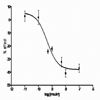A novel, rapid, inhibitory effect of insulin on alpha1beta2gamma2s gamma-aminobutyric acid type A receptors
- PMID: 18672028
- PMCID: PMC2597579
- DOI: 10.1016/j.neulet.2008.07.038
A novel, rapid, inhibitory effect of insulin on alpha1beta2gamma2s gamma-aminobutyric acid type A receptors
Abstract
In the CNS, GABA and insulin seem to contribute to similar processes, including neuronal survival; learning and reward; and energy balance and food intake. It is likely then that insulin and GABA may interact, perhaps at the GABA(A) receptor. One such interaction has already been described [Q. Wan, Z.G. Xiong, H.Y. Man, C.A. Ackerley, J. Braunton, W.Y. Lu, L.E. Becker, J.F. MacDonald, Y.T. Wang, Recruitment of functional GABA(A) receptors to postsynaptic domains by insulin, Nature 388 (1997) 686-690]; in it a micromolar concentration of insulin causes the insertion of GABA(A) receptors into the cell membrane, increasing GABA current. I have discovered another effect of insulin on GABA(A) currents. Using a receptor isoform, alpha(1)beta(2)gamma(2s) that is the likely main neuronal GABA(A) isoform expressed recombinantly in Xenopus oocytes, insulin inhibits GABA-induced current when applied simultaneously with low concentrations of GABA. Insulin will significantly inhibit currents induced by EC(30-50) concentrations of GABA by about 38%. Insulin is potent in this effect; IC(50) of insulin was found to be about 4.3 x 10(-10) M. The insulin effect on the GABA dose responses looked like that of an antagonist similar to bicuculline or beta-carbolines. However, an effect of phosphorylation on the GABA(A) receptor from the insulin receptor signal transduction pathway cannot yet be dismissed.
Figures



Similar articles
-
Neurosteroid modulation of recombinant rat alpha5beta2gamma2L and alpha1beta2gamma2L GABA(A) receptors in Xenopus oocyte.Eur J Pharmacol. 2006 Oct 10;547(1-3):37-44. doi: 10.1016/j.ejphar.2006.07.039. Epub 2006 Jul 27. Eur J Pharmacol. 2006. PMID: 16934248
-
Bilobalide, a sesquiterpene trilactone from Ginkgo biloba, is an antagonist at recombinant alpha1beta2gamma2L GABA(A) receptors.Eur J Pharmacol. 2003 Mar 7;464(1):1-8. doi: 10.1016/s0014-2999(03)01344-x. Eur J Pharmacol. 2003. PMID: 12600688
-
Valerenic acid potentiates and inhibits GABA(A) receptors: molecular mechanism and subunit specificity.Neuropharmacology. 2007 Jul;53(1):178-87. doi: 10.1016/j.neuropharm.2007.04.018. Epub 2007 May 13. Neuropharmacology. 2007. PMID: 17585957
-
Subunit-dependent block by isoflurane of wild-type and mutant alpha(1)S270H GABA(A) receptor currents in Xenopus oocytes.Neurosci Lett. 2005 Jul 15;382(3):332-7. doi: 10.1016/j.neulet.2005.03.029. Epub 2005 Apr 14. Neurosci Lett. 2005. PMID: 15925114
-
Effects of hexachlorocyclohexanes on gamma-aminobutyric acid receptors expressed in Xenopus oocytes by RNA from mammalian brain and retina.Mol Pharmacol. 1992 Jun;41(6):1107-15. Mol Pharmacol. 1992. PMID: 1377327
Cited by
-
GABA coordinates with insulin in regulating secretory function in pancreatic INS-1 β-cells.PLoS One. 2011;6(10):e26225. doi: 10.1371/journal.pone.0026225. Epub 2011 Oct 21. PLoS One. 2011. PMID: 22031825 Free PMC article.
-
A mutant residue in the third transmembrane region of the GABA(A) alpha1 subunit causes increased agonistic neurosteroid responses.Neurochem Int. 2011 Jun;58(7):794-803. doi: 10.1016/j.neuint.2011.03.005. Epub 2011 Mar 21. Neurochem Int. 2011. PMID: 21397651 Free PMC article.
-
Hierarchical glucocorticoid-endocannabinoid interplay regulates the activation of the nucleus accumbens by insulin.Brain Res Bull. 2016 Jun;124:222-30. doi: 10.1016/j.brainresbull.2016.05.009. Epub 2016 May 18. Brain Res Bull. 2016. PMID: 27208730 Free PMC article.
-
In vivo electrophysiological effects of insulin in the rat brain.Neuropeptides. 2009 Aug;43(4):283-93. doi: 10.1016/j.npep.2009.05.006. Epub 2009 Jun 21. Neuropeptides. 2009. PMID: 19541365 Free PMC article.
-
Insulin in the brain: sources, localization and functions.Mol Neurobiol. 2013 Feb;47(1):145-71. doi: 10.1007/s12035-012-8339-9. Epub 2012 Sep 7. Mol Neurobiol. 2013. PMID: 22956272 Review.
References
-
- Ahren B, Holst JJ. The cephalic insulin response to meal ingestion in humans is dependent on both cholinergic and noncholinergic mechanisms and is important fort postprandial glycemia. Diabetes. 2001;50:1030–1038. - PubMed
-
- Anthony KA, Reed LJ, Dunn JT, Bingham E, Hopkins D, Marsden PK, Amiel SA. Attenuation of insulin-evoked responses in brain networks controlling appetite and reward in insulin resistance: the cerebral basis for impaired control of food intake in metabolic syndrome? Diabetes. 2006;55:2986–2992. - PubMed
-
- Azimi-Zoonoz A, Shuttleworth CW, Connor JA. GABAergic protection of hippocampal neurons against glutamate insult: deficit in young animals compared to adults. J Neurophysiol. 2006;96:299–308. - PubMed
Publication types
MeSH terms
Substances
Grants and funding
LinkOut - more resources
Full Text Sources
Medical
Miscellaneous

